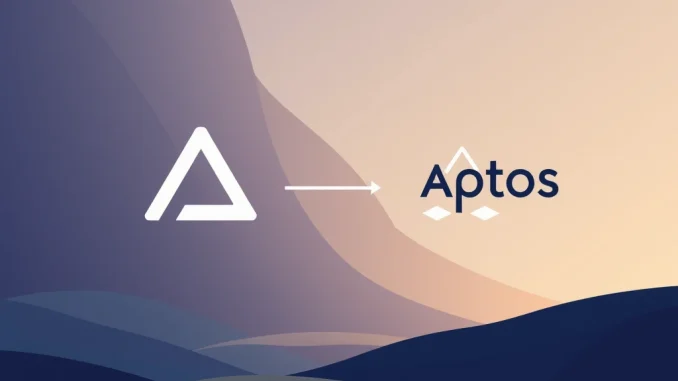
Big news shaking up the decentralized finance (DeFi) world! The Aave community has given the green light, voting overwhelmingly in favor of deploying the Aave V3 protocol onto the Aptos Mainnet. This move marks a significant step for both Aave and the burgeoning Aptos ecosystem, promising to bring one of the largest and most established DeFi lending protocols to a blockchain known for its speed and scalability.
What Does Aave V3 on Aptos Mean for DeFi?
The deployment of Aave V3 on the Aptos blockchain is set to introduce a robust and battle-tested lending and borrowing market to a relatively new chain. Aave V3 brings several key improvements over previous versions, designed to enhance capital efficiency, improve risk management, and offer greater flexibility for users.
Key features of Aave V3 include:
- Efficiency Mode (E-Mode): Allows borrowers to achieve higher capital efficiency when borrowing assets correlated in price (e.g., stablecoins).
- Isolation Mode: Enables the listing of new, potentially riskier assets with limited collateral risk to the protocol.
- Portal: Facilitates seamless cross-chain transfers of assets between Aave V3 markets on different networks.
- Supply Cap and Borrow Cap: Provides more granular control over risk management for specific assets.
Bringing these features to Aptos could unlock new opportunities for users seeking diversified lending and borrowing options on a high-performance chain. It’s a clear signal of Aave’s strategy to expand its reach and tap into growing blockchain ecosystems.
Exploring the Aptos Blockchain: Why is it a Fit?
The Aptos blockchain has gained attention for its focus on scalability, safety, and upgradability. Built by former Meta employees, it utilizes the Move programming language, designed with security and formal verification in mind. This architecture aims to prevent common smart contract vulnerabilities.
Aptos boasts features like:
- High transaction throughput and low latency.
- Parallel execution engine (Block-STM) for efficient processing of multiple transactions simultaneously.
- Emphasis on security through the Move language and frequent upgrades.
- A growing ecosystem of decentralized applications (dApps).
For a protocol like Aave, deploying on Aptos offers access to a chain designed for high transaction volumes and potentially lower gas fees compared to some established networks. This could make DeFi lending and borrowing more accessible and cost-effective for a wider range of users.
Understanding Aave Governance and the Approval Process
This significant step was made possible through the decentralized governance process of the Aave protocol. Aave is governed by its token holders, who propose and vote on changes and upgrades to the protocol, including deployments on new chains.
The process typically involves:
- A proposal is submitted detailing the technical specifications, rationale, and potential impact of the change (in this case, deploying V3 on Aptos).
- Community discussion and feedback on the proposal.
- A Snapshot vote occurs, allowing AAVE token holders to signal their support or opposition based on their token holdings.
- If the Snapshot vote passes, an on-chain governance proposal is created and voted upon by token holders.
- If the on-chain vote passes, the proposed change is executed, often involving timelocks for security.
The successful vote demonstrates the community’s confidence in the strategic importance of expanding Aave V3 to new, promising ecosystems like Aptos. This model of crypto governance is fundamental to how decentralized protocols evolve and adapt.
Impact on Users and the Broader Crypto Ecosystem
The deployment of Aave Aptos is poised to have several positive impacts:
- For Aptos Users: Provides access to a leading DeFi lending protocol, enabling them to earn yield on assets or borrow against collateral. This adds a critical financial primitive to the Aptos ecosystem.
- For Aave Users: Offers a new network option with potentially different fee structures and performance characteristics. It expands Aave’s total addressable market and liquidity base.
- For the DeFi Landscape: Represents another step towards a multi-chain future, where major protocols are accessible across various networks, increasing interoperability and resilience.
- For the Aptos Ecosystem: Attracts liquidity and users, bolstering Aptos’s position as a viable platform for decentralized applications.
While exciting, challenges could include initial liquidity bootstrapping on Aptos, integrating with the Move language environment, and educating users on using Aave V3 on a new chain. However, the successful governance vote indicates the community believes the benefits outweigh these potential hurdles.
What’s Next? Actionable Insights
For those interested in this development:
- Keep an eye on official announcements: Follow Aave and Aptos channels for the exact deployment timeline and details.
- Learn about Aptos: If you’re primarily an Aave user, take time to understand the Aptos network, its wallet options, and how to bridge assets.
- Understand Aave V3 features: Familiarize yourself with E-Mode, Isolation Mode, and other V3 specifics before using the protocol on Aptos.
- Monitor liquidity: Initial liquidity on the new market will be crucial. Watch how quickly assets are supplied and borrowed.
This deployment is more than just a technical upgrade; it’s a strategic expansion that could significantly impact the growth of both Aave and the Aptos blockchain within the broader DeFi space.
Conclusion: A Strategic Expansion for Aave and Aptos
The Aave community’s decision to deploy Aave V3 on the Aptos Mainnet is a landmark event. It signifies Aave’s commitment to expanding its reach across high-performance blockchains and Aptos’s growing maturity as a platform capable of hosting major DeFi protocols. This move promises to bring advanced lending and borrowing capabilities to the Aptos ecosystem, potentially attracting new users and liquidity, and further solidifying the vision of a interconnected, multi-chain decentralized future. It’s an exciting time to watch how this integration unfolds and contributes to the evolution of decentralized finance.



